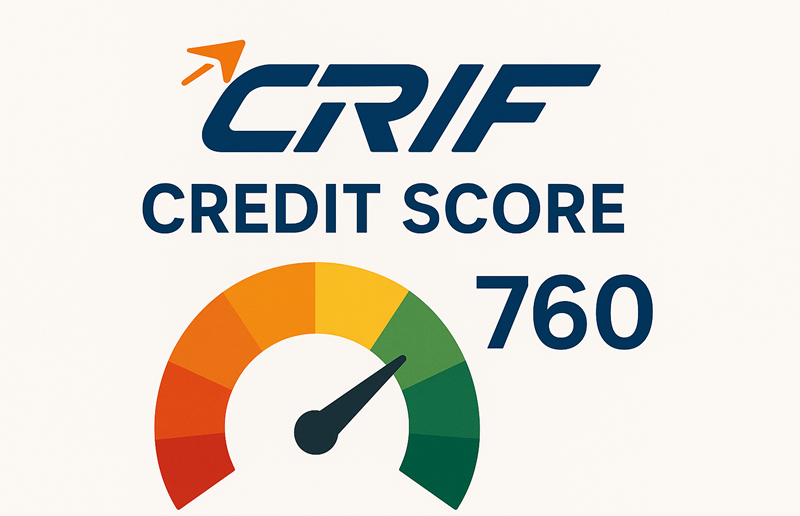

Did You Know?
We serve loans, the best way you can borrow

We serve loans, the best way you can borrow

Monitoring your CRIF credit score gives you control over your financial future. Regular monitoring helps catch issues early and opens doors for better interest rates. Find out more about the steps to check the score in this all-encompassing post.
The CRIF credit score represents your creditworthiness as a three-digit number ranging from 300-900. Higher scores signal greater reliability to lenders when you apply for personal loans. CRIF High Mark started operations in India in 2010 and has quickly gained trust among financial institutions.
The Reserve Bank of India (RBI) and Securities and Exchange Board of India (SEBI) recognise this credit bureau. Your past payment behaviour directly affects this score. The CRIF Highmark score provides lenders with insight into your potential risk level.
Getting your CRIF score check done takes only minutes and helps you understand your financial standing better.
1. Visit the Official CRIF Website
Go to the CRIF High Mark official website and find the "Free Score" section at the bottom. Click on "Get Your Score Now" to start the process.
2. Fill Required Details
Enter your legal name, identification type, ID number, mobile number, and email address carefully. Check the box agreeing to terms and conditions before clicking "Get My Credit Score." Double-check all information for accuracy to avoid delays.
3. Verify with OTP
You'll receive a six-digit OTP on your mobile phone. Enter this code on the website and click "Verify" to proceed with the authentication process.
4. Answer Security Questions
Answer a few basic questions to confirm your identity. These questions typically relate to your financial history and previous credit accounts.
5. View Your Score and Report
Once verification is completed, your CRIF credit score and detailed report appear on the screen. You can download this report for future reference or to share it with potential lenders.
Preparing the right documents beforehand makes checking your CRIF credit score quick and hassle-free.
1. Personal Identification
Keep your PAN card, voter ID, passport, driving license, or ration card ready. CRIF needs only one of these identification documents to verify your identity.
2. Contact Information
Have your current mobile number and email address available. You'll receive verification codes on these contact points during the process.
3. Basic Details
Remember your full legal name, date of birth, and age as they appear on official documents.
Understanding what lendingplate offers through CRIF helps you choose the right services.
1. Free Credit Score Access
lendingplate provides free CRIF credit score checks once every month without hurting your score.
2. Comprehensive Credit Reports
Their detailed reports show your entire credit history, including loans, credit cards, and payment patterns. These reports highlight potential issues that might affect your borrowing ability. You can spot mistakes or fraud early by reviewing these reports.
3. Credit Improvement Plans
lendingplate offers personalised advice on how to boost your CRIF credit score over time. Their experts suggest specific actions based on your unique financial situation. The plans focus on practical steps rather than quick, temporary fixes.
4. Loan Eligibility Checker
Their pre-qualification tool shows which loans you might qualify for based on your credit profile. This saves time by helping you apply only for loans you're likely to get. The tool considers your CRIF credit score and other financial factors.
Understanding how your CRIF credit score gets calculated helps you make better financial decisions that improve your rating.
1. Payment History
On-time payments boost your score significantly. Late payments and defaults can lower your score for years.
2. Credit Utilisation
Using less than 30% of available credit shows responsible behaviour. High balances relative to limits signal potential financial trouble.
3. Length of Credit History
Longer credit histories provide more data for accurate scoring. New borrowers naturally have lower scores initially.
4. Credit Mix
Having different types of loans shows the ability to manage varied obligations. Both secured and unsecured credit contribute to a stronger profile.
5. New Credit Applications
Frequent applications suggest possible financial distress—space out your loan inquiries by at least six months.
Your CRIF credit score falls somewhere between 300 and 900, with higher numbers indicating better creditworthiness.
| Score Range | Rating | Loan Approval Chances |
|---|---|---|
| 300-549 | Poor | Very Low |
| 550-649 | Fair | Moderate but with higher interest |
| 650-749 | Good | High with reasonable interest |
| 750-900 | Excellent | Very High with the best rates |
Most lenders prefer scores above 700 for approving loans with favourable terms.
Difference between Crif and Cibil
Both bureaus provide credit information but differ in several important ways that affect how you monitor your financial health.
1. Founding and History
CIBIL started in 2000 as India's first bureau. CRIF report services began in 2010, making it relatively newer but rapidly growing.
2. Data Collection Methods
CIBIL Score traditionally focused on urban and semi-urban borrowers. CRIF includes rural borrowers and microfinance data, creating a more inclusive profile.
3. Score Range Interpretation
Both use the 300-900 range, but scoring algorithms differ slightly. Some lenders might place different emphasis on scores from each bureau.
4. Report Format
Now you know what is CRIF credit report. Remember, the structure differs from CIBIL's layout and presentation. CRIF reports often include more detailed microfinance loan information.
The CRIF credit report means a comprehensive document showing your entire credit history and financial behaviour. This report includes all your loan accounts, payment patterns, and credit applications. Lenders review this information before approving loans or credit cards.
The report highlights potential red flags like late payments or defaults. You can access one free report annually from CRIF High Mark. Regular review helps catch and dispute errors that might hurt your score.
Financial institutions rely on this document to determine your reliability as a borrower. A clean report increases your chances of loan approval with favourable terms. The report also shows your total debt burden across all lending institutions.
The CRIF report contains detailed information about your financial behaviour that lenders use to evaluate creditworthiness.
1. Personal Information
Your name, date of birth, address, and contact details appear in this section. Any discrepancies here should be immediately reported and corrected.
2. Account Details
This section lists all your credit accounts, including loans and credit cards. It shows loan amounts, current balances, and account opening dates.
3. Payment History
Your monthly payment records for each account appear chronologically. Any delayed payments or defaults are highlighted with dates and duration.
4. Credit Inquiries
Every time someone checks your credit report, it gets recorded here. Too many inquiries in a short period might lower your score.
5. Public Records
Any financial legal matters, like bankruptcies, appear in this section. These records seriously impact your creditworthiness for several years.
Even small mistakes in your credit report can significantly impact your CRIF high mark score and loan eligibility.
1. Personal Detail Errors
Misspelled names or incorrect addresses can create confusion about your identity.
2. Wrong Account Status
Closed accounts sometimes appear active or vice versa.
3. Duplicate Accounts
The same account might appear twice, making your debt seem higher.
4. Payment Discrepancies
On-time payments incorrectly marked as late damage your score unfairly.
5. Incorrect Balance Information
Outdated balance information fails to reflect recent payments you've made.
Finding errors in your CRIF high mark score feels frustrating, but you can fix them through a straightforward dispute process. First, download your complete credit information report from the official website. Carefully review every section for inaccuracies in personal details, account information, and payment history.
Once you've identified errors, go to the website and click on "Raise a Query" in your account dashboard. Select the appropriate dispute category that best describes your issue. Provide clear details about each error and upload supporting documents proving your claim. Good evidence includes bank statements, payment receipts, or account closure confirmations.
CRIF High Mark must investigate disputes within 30 days by law. During this period, they'll contact the concerned lenders to verify your claims.
Your CRIF credit score directly impacts your financial freedom. Regular monitoring helps catch and fix errors before they harm your borrowing power. lendingplate offers financial solutions even if your score needs improvement. Take charge today by checking your report and addressing any issues.
Q.1. Can you explain the CRIF High Mark score and how to check it without any cost?
The CRIF credit score ranges from 300 to 900 and reflects your creditworthiness. You can check it for free once a year on their official website by providing basic details.
Q.2. What is the CRIF report password?
After requesting your CRIF report, you'll receive an email with a password-protected PDF. The password typically combines your initials and birth date in DDMMYYYY format.
Q.3. What types of errors can be corrected in a credit report?
Common correctable errors include wrong personal details, incorrect account statuses, duplicate listings, inaccurate payment histories, and outdated loan balances.
Q.4.How long does it take for errors in a CRIF report to be corrected?
The correction process typically takes 30 days from filing your dispute. CRIF must investigate claims within this timeframe as per regulations.
Q.5. Is CRIF the same as a credit score?
CRIF High Mark is the credit bureau, while the CRIF credit score is the numerical rating they provide. The bureau collects financial data from lending institutions, and the score represents their assessment of your creditworthiness based on this information.
Q.6. What is considered a good CRIF credit score?
A CRIF credit score above 750 is considered excellent and attracts the best loan terms. Scores between 650-749 are good, offering reasonable approval chances.
Q.7. How much does a CRIF credit report cost?
You're entitled to one free CRIF report annually. Additional reports cost between ₹550, depending on the detail level requested.
Q.8. How often can I check my CRIF credit score?
You can check your CRIF credit score as often as you want, but only one check per year is free. Frequent checks won't affect your score as these are considered "soft inquiries.
Q.9. Is the CRIF credit score used by all financial institutions?
Many lenders use the CRIF credit score, but not all. Some prefer CIBIL, Experian, or Equifax scores. Major banks often check reports from multiple bureaus before making lending decisions. lendingplate considers various factors beyond just credit scores.
Q.10. What are the CRIF High Mark customer care numbers?
Reach CRIF High Mark customer support at 020-6715-7771/7776/7779/7780. Customer service operates Monday through Friday from 10:00 AM to 6:00 PM IST.
Q.11. What are the charges that I need to pay to get my CRIF High Mark credit report?
Your first CRIF report each year comes free by law. Additional reports cost ₹399 for basic versions.
Download our personal loan app to apply for a personal loan. Get up to 2Lakhs* as a personal loan. Download Now!
Sign into avail a personal loan up to ₹ 2,50,000
Register to avail an instant loan in just a few minutes. Fulfil your financial needs with our loan and repay in easy EMIs.
Apply NowUnifinz Capital India Limited is a Non Banking Finance Company (NBFC) registered with the Reserve Bank of India (RBI). lendingplate is the brand name under which the company conducts its lending operations and specialises in meeting customer’s instant financial needs.
Corporate Identity No. (CIN)
L 1 7 1 1 1 D L 1 9 8 2 P L C 0 1 3 7 9 0
RBI Certificate of Registration No (CoR):
1 4 . 0 0 2 3 3
Registered Office :
Rajlok Building (Floor-5), 24 Nehru Place, New Delhi-110 019